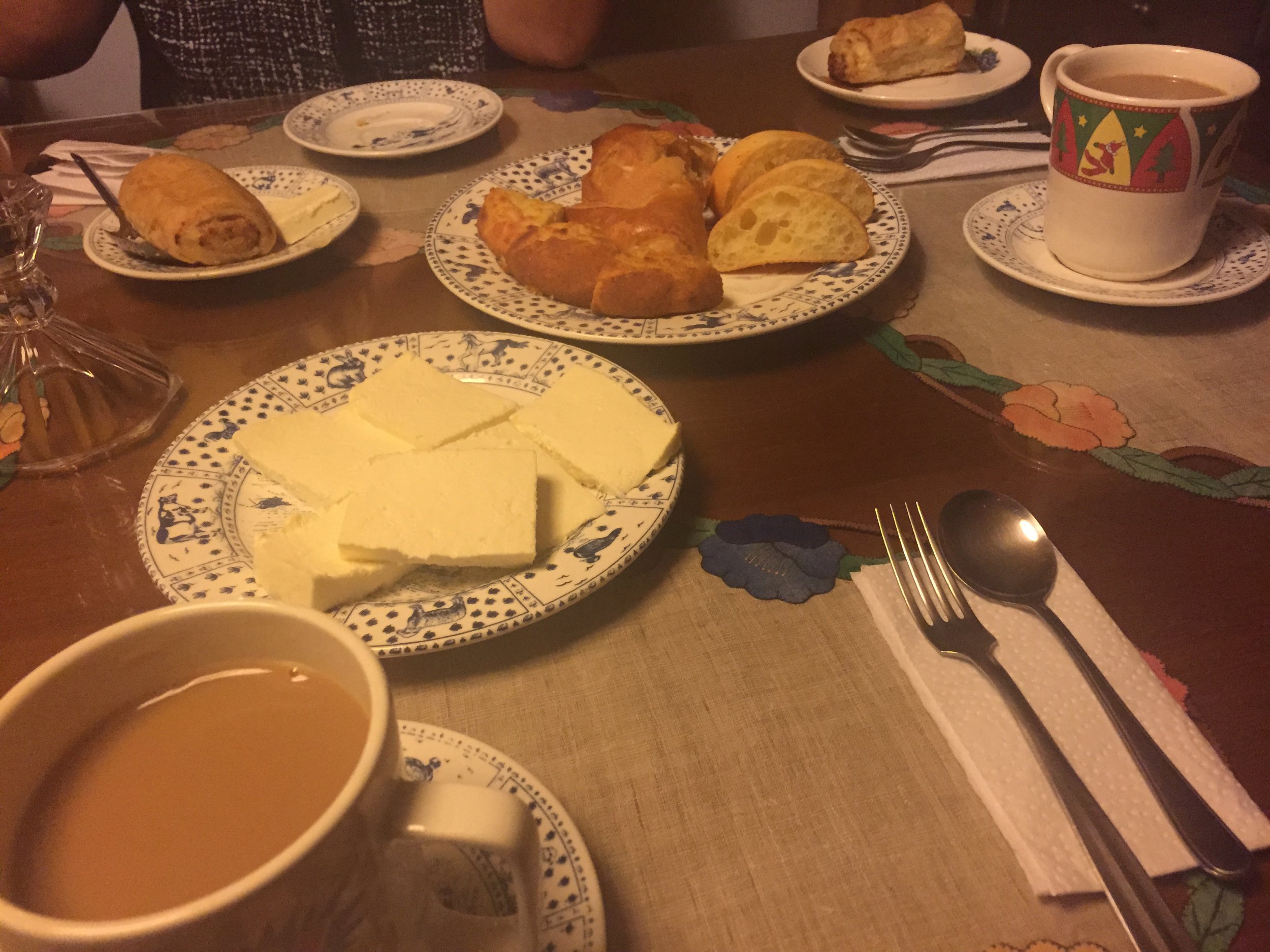Setting the Table: An Act of Hospitality and Welcome
by the Rev. Shannan Vance-Ocampo
“Hurry up!” I yelled from the kitchen to the dining room.
I was frazzled, stressed, trying to be perfect.
“Hurry up! They will be here soon! Set the table!”
I stayed in the kitchen, working to make sure dinner would be perfect. My husband was almost home, carrying in his car precious cargo--his cousin and one of his very best friends, Juan Carlos, and his family, visiting our new home in New Jersey for the first time. I wanted to make sure dinner was ready when they got to the house. I wanted everything to be perfect. I wanted everyone to know that I was doing everything just right.
The only help I had was my 7-year old daughter who was in the dining room and I had charged with setting the table for dinner. At the time she was going through the stage where she made adorable place settings for everyone at most meals and would try to make origami-style designs with paper napkins.
“Sofia! Are you listening to me?! Set the table!” I yelled to her again from the kitchen--throwing my anxiety across the house towards her.
There was no answer. So I went into the dining room. As I walked in I took a deep breath and time stopped. She had set the table. And she’d set it the way my Colombian mother-in-law sets her table in Bogotá, not the way I taught her. She knew the Colombian side of our family would be arriving for dinner, and so she set the table the way they knew it--and not in the Anglo-American style I had taught her myself.
Immediately I was brought up short.
Here I was zooming all around the house, the typical anxiety-filled North American cultural desire to impress and be perfect with external details. And here was my child who instinctively knew that to welcome someone into our home, we had to set things up the way that made our guests feel comfortable. Somehow she knew that something so small like where the fork and the knife went would be something so big--so filled with meaning and hospitality. And she was proud of herself.
“I set the table Mommy.”
I remember being a small child and sitting at the dining room table in our home, probably before a holiday, perhaps Thanksgiving or Christmas. My mother took out large velvet pouches, and in them were our silver cutlery for setting the table and for serving at the table. She showed me how to set the table, the fork on the left, and if you put an extra fork for salad it meant we were setting the table for something fancy, not just everyday. I have taught my daughter this, never imagining that she was paying attention to how to set another sort of table.
You see, I had on my own blinders around table manners and hospitality. I noticed of course, when visiting my husband’s family in Colombia that they set the table differently--but I never bothered to imagine that this is something to talk to my daughter about or to try to do in my own home, maybe to make my immigrant husband feel more at home in the country he has chosen to live in but still feels like exile in so much of the time. Because of the way I was raised, in the culture I was raised in--these things were beyond my vision, far from my imagination until that rushed day when I was racing around trying to have dinner ready. In my rushing I hadn’t noticed what my daughter had done to our dining room table until it made me stop short. She instinctively knew what to do perfectly, and she understood the deep subtleties of hospitality in a way I would never in my lifetime be able to do without needing to remember to think first. I stood there in my dining room, caught off guard, amazed and in awe.
What else was I missing that she noticed? What else did I need to do? Where else was I engaged in everyday activities that communicated my cultural dominance in our home?
That day started a shift in me. All relationships are a challenge, but when you meld together two cultures the way we have in our home it is both an indescribable joy and challenge. I am on a constant learning curve and my daughter is always steps ahead of me. That day, and the confession I share with you of my behaviors, also started me on a journey in my ministry and in my life of asking the deeper questions about hospitality and welcome. How do we welcome? What is real hospitality? How do we set the table? How can we allow the in-breaking of the Holy Spirit--which is what happened to me through my daughter on that day--to allow the opportunity for rebirth and renewal?
As Christians we know that tables are also sacramental.
Much of the time in our religious communities we only know how to “set the table” one way or maybe one or two ways that are historical, comfortable, known. And we all know what happens when you start to do some re-setting or re-ordering of those tables!
I believe that if we want to lean into our ministry in new ways, engage in the work of evangelism, hospitality and discipleship in this time, we are going to have to learn how to set the tables in our homes and in our religious communities in new ways. Sometimes this might be easy or fun, most of the time it will be a challenge. Alliances will shift. Places might change. The instruments and implements might be in places where we don’t know what to do with them. The colors may be brighter or dimmer or a whole new palate altogether. And maybe, just maybe you or I may no longer have the “honored” seat or a seat at all. This is transformative, deep, long work that we are called to for the health and future of the communities we steward in this time.
My life has been teaching me also how exclusive tables can be. Many times my husband will tell me, “I have been here in the United States for sixteen years. But I do not feel I belong. This place does me no favors and doesn’t really want to welcome me. Sometimes, I still can’t follow the conversation.” Lately, he and my daughter have been saying that the rhetoric of this season has made them feel unwelcome entirely. A few weeks ago we arrived in the United States on our way back to the United States from Colombia, and the first encounter after clearing customs was with a white supremacist, offering words of hatred, mockery and violence to those around him. “Why did we come back here?” we wondered. Within moments of returning, the unwelcome-mat was rolled out in many ways direct and subtle. And the pain was incredible for myself but even more so for my beloved husband and daughter.
As we look around or hopefully walk around and engage our communities wherever God has called us, notice those who set the table differently than how you have been taught. What is their experience? What are they communicating in how they set their table? How does Jesus show up to these Tables? And how can you be caught off guard just enough to be forced to take a breath and notice your own challenges and opportunities for rebirth?
Two resources:
This summer I read the expansive book on table-setting, hospitality, liturgy and the sacrament of communion by Brazilian theologian Cláudio Carvalhaes, Eucharist and Globalization: Redrawing the Borders of Eucharistic Hospitality. I can’t recommend it enough. Rev. Dr. Carvalhaes also preached an amazing convocation sermon on September 7, 2016 at Union Theological Seminary in the City of New York. The text and video can be accessed at this link. What a gift it might be to show this video at your community of faith and talk about how this is an opening convocation sermon for those just entering seminary and reflect on its meaning and challenge….
I also read The End of White Christian America this summer by Robert Jones. I highly recommend this book as a way of digging deep into what is happening around us and the death and loss so many of our communities are experiencing right now and how that is being lived out in fear and anger. PBS did a great short interview on this book and its author. What a gift it might be to read this book together as a community and discuss what it means in your context, sharing conversation and vulnerability with each other.
Rev. Shannan R. Vance-Ocampo serves as the Transitional Presbyter for Albany Presbytery. Previously she has served in Monmouth and Elizabeth presbyteries in New Jersey. She currently is a member of the Synod’s Working Group on Race and she is also a member of the Activist Council of the Presbyterian Peace Fellowship where she has been working on human rights in Colombia, South America for the last ten years with the collaborative Colombia Accompaniment Program. She lives in Albany with her husband, Juan Gabriel Ocampo Valle and their daughter, Sofia Elena Ocampo-Vance. You can find her online at http://shannanvo.com

